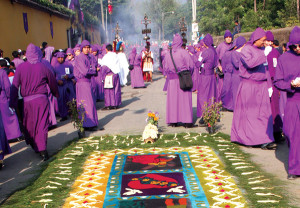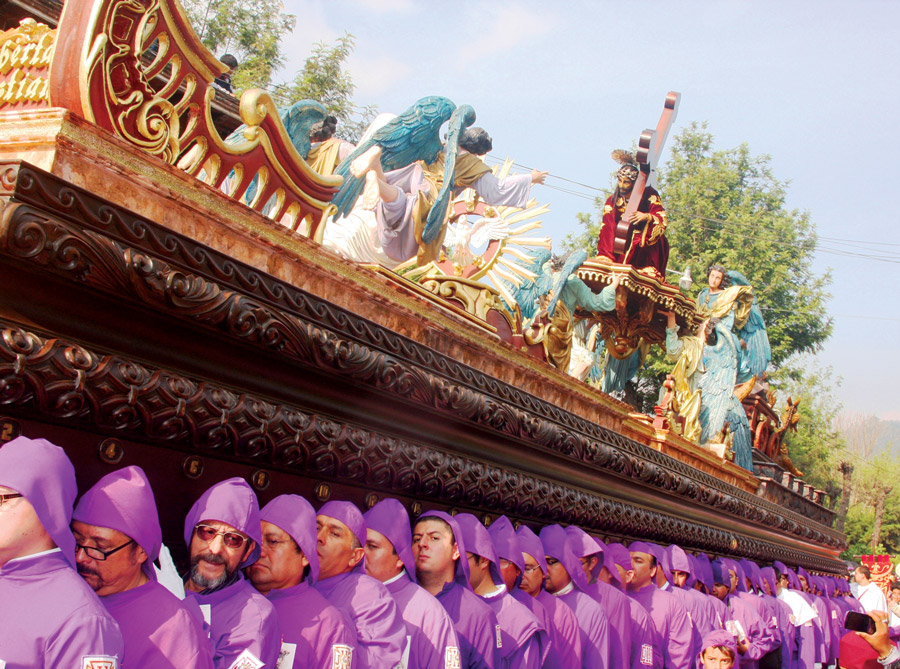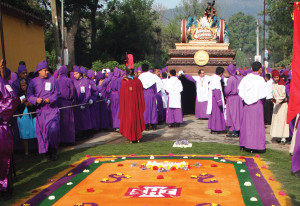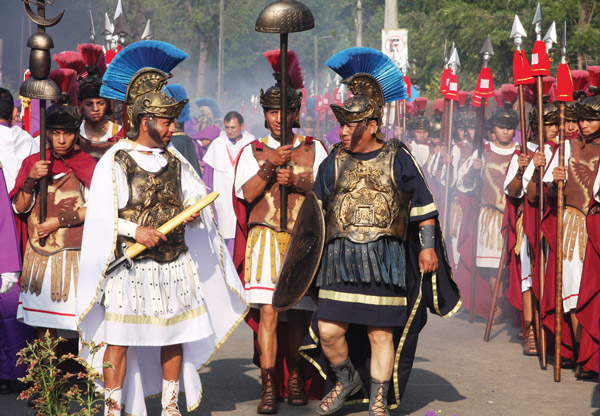The procession of Jesús Nazareno de la Caída de San Bartolomé Becerra
5th Sunday of Lent. March 13, leaves at 6am, returns at midnight. Passes Antigua’s Central Park at 4:30pm. For the online mobile interactive 2016 PROCESSION ROUTE click here.
A day of pageantry and devotion.
I remember waking at the stroke of 6 last year on the fifth Sunday of Lent in San Bartolo, a charming suburb of La Antigua Guatemala where I was living at the time. World-renowned for its exquisite colonial architecture, Antigua is also host to one of the largest and most elaborate celebrations of Cuaresma or Lent in all of Latin America.
Each Sunday during Lent, and leading up to Semana Santa or Holy Week, several local congregations sponsor religious processions that depart from their church and follow various routes through the streets of Antigua before returning to their parish hours later.
The Jesús de la Caida de San Bartolomé Becerra procession, which occurs on the fifth Sunday of Lent, is one of the grandest. It leaves San Bartolo at 6 a.m. on Sunday, winds its way through the cobbled streets of Antigua, and returns the following Monday morning after midnight. (route map)
According to longtime San Bartolo resident Gabriel López Corado, also known as Don Gabo, the first procession took place around 1902. “It started out with only a handful of people because the parish was very poor,” he explained. “Today, thousands pay just for the privilege of carrying the float or anda that bears the Fallen Christ. The money then goes to the hermandad—a committee that organizes religious activities—to help fund what has now become an internationally renowned event.”
The processions, which re-enact Christ’s last days in Jerusalem, are attended by tens of thousands, including throngs of visitors from around the world. Because I had already been in Antigua four years earlier on Good Friday, I had a sense of what to expect.
On this magnificent morning, however, as I stepped out from behind a huge wooden gate onto the main carretera, I felt as though I were in a time warp some 2,000 years past. It was like being on the set of a Cecil B. DeMille film. The scene unfolding in front of my apartment complex was simply stunning if not surreal.
As I made my way through clouds of incense, just 10 feet ahead of me stood an entire Roman army, bearing swords and shields. Some were carrying spears, which can be used to lift electric lines out of the way of the religious statues that are transported on huge hand-carried floats.
Street vendors had already started selling delectable breakfast treats, including enchiladas, warm tortillas, beans, rice, grilled meats and sweets. And there was an endless supply of toys and colorful balloons for the children.
Cucuruchos—men who carry the floats and images during Lent—walked along both sides of the roadway, keeping a path clear for the float and its bearers while ensuring the alfombras remained intact. The alfombras or carpets are prepared throughout the processional routes using pine needles, fresh flowers, brilliantly colored sawdust and sand.
I had to walk a mile to return to my complex the night before because the streets had already been closed off while locals created their masterpiece alfombras. I chatted with some of the creators and asked one of them how long she had been working on her alfombra. “Four hours,” she replied, and she still had a ways to go. It was 1 a.m. but there was enough time.

Cucuruchos—men who carry the floats and images during Lent—walked along both sides of the roadway, keeping a path clear for the float and its bearers.
The art of the alfombra is truly ephemeral, an act of pure faith because in a matter of hours, her magnificent work would vanish beneath worshippers’ feet as a huge, hand-carried float bearing the Fallen Christ of San Bartolomé Bercerra crossed over it.
Don Gabo, who served as a member of the San Bartolo Hermandad for over 30 years, explained that the image of the Fallen Christ is attributed to sculptor Pedro de Mendoza. Unlike many of the Nazarene images in which Jesus is portrayed in an upright position, the Fallen Christ or Jesús Nazareno de la Caída symbolizes the episodes in which Jesus fell under the weight of the cross on the way to Calvary for his crucifixion.
“After the devastating earthquake of 1976 that destroyed Antigua, many of the sculptures and images were taken away to Guatemala City,” Don Gabo recounted. “Others, including Jesús de la Caída, wound up in the nearby San Jerónimo ruins of Antigua.”
With the help of some prominent community members, the sculpture was ultimately rescued from San Jeronimo and returned to San Bartolo. “Jesús Nazareno de la Caída is like a member of the San Bartolo family and is referred to as a living person,” Don Gabo stated. “He even has two crowns, one of which is only worn on the day of the procession.”
REVUE article, text and photos by Kerstin Sabene



I was in Antigua in 1990 for Semana Santa. It was very beautiful. The sawdust drawings on the streets were exquisite, too bad they had to be destroyed later in the day by the procession. It was a very warm day for Antigua. April seemed like the warmest month of the year.
Pingback: Antigua's First Interactive Mobile Procession Map - Revue Magazine